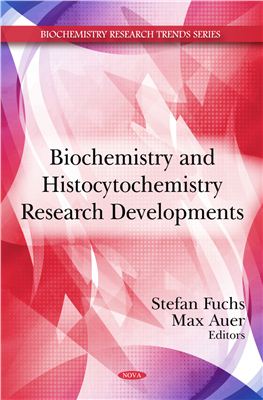Nova Science Publishers, Inc. 2010. - 361 p.
Biochemistry is the organic chemistry of compounds and processes occurring in organisms. Histocytochemistry is the study of intracellular distribution of chemical, reaction sites, enzymes, etc. by means of staining reactions, radioactive isotope uptake, selective metal distribution in electron microscopy, or other methods. This book focuses on the role of norepinephrine in neuroinflammation, discusses the contribution of norepinephrine to Alzheimer's (AD) and Parkinson's Disease (PD) and provides an overview of potential therapeutical options targeting this neurotransmitter. Using methodologies such as questionnaires and laboratory tasks, experimental results showing specific effects related to noradrenaline in both clinical and experimental studies are described. This book also provides the current findings on the relationships between sympathetic nerve activity, B-adrenoceptor polymorphisms, and renal function. Recent methodologies that are useful for advanced immunohistochemistry (IHC) analysis in pathological research into therapeutic agents is also analyzed. Other chapters in this book discuss the unresolved areas of plasma cell research, an analysis of a new technology based on B-Cell targeting and its advantages over conventional methods for selective generation of novel monoclonal antibodies, as well as a review of the regulation of proteases and their role during the biocontrol process. Recent advances in the
isolation and characterization of glycosidases from hyperthermophilic microorganisms and the methods used for their application in oligosaccharide synthesis are explored as well.
Contents
Preface
Chapter 1 Function of Norepinephrine in Neuroinflammation and Chronic Neurodegenerative Diseases
Johannes C.M. Schlachetzki, Antonio C. Pinheiro de Oliveira, and Bed L. Fiebich
Chapter 2 The Role of Noradrenaline on Interpersonal Functioning
Wai S. Tse and Alyson J. Bond
Chapter 3 The Neurotransmitter Norepinephrine and its Role in Affective Disorders
Eliyahu Dremencov
Chapter 4 The Role of Sympathetic Nerve Activity in Renal Injury
Kazuko Masuo, Gavin W. Lambert and Murray D. Esler
Chapter 5 Quantitative Immunohistology - Problems and Solutions
Anthony S.Y. Leong and Trishe Y.M. Leong
Chapter 6 Immunohistochemical Basis for Orthodontic Treatment
Toshiyuki Kawakam, Keisuke Nakano, Takako Shimizu, Takehiro Watanabe, Rina Muraoka, Akihiro Kimura and Hiromasa Hasegawa
Chapter 7 Pathological Research on Molecular-Targeted Therapy and Advanced Immunohistochemical Approaches
Yutaka Hatanaka, Yuki Imaoka, Kaoru Hashizume, and Robert Y Osamura
Chapter 8 Pre-Embedding Scarce Biological Specimens for Light and Electron Microscopy
Philippe Taupin
Chapter 9 Role of Surrogate Light Chain Expressing B Cells in the Formation of Self-Reactive Antibodies
Pieter Fokko van Loo, Laurens P. Kil and Rudi W. Hendriks
Chapter 10 Unique Enzymes of Aspergillus Fungi Used in Japanese Bioindustries
Eiji Ichishima
Chapter 11 Extracellular Proteases of Entomopathogenic Fungi
L?r?nt Hatvani, L?szl? Kredics, S?ndor Kocsub?, L?szl? Manczinger, Csaba V?gv?lgyi, Zsuzsanna Antal
Chapter 12 Glycoside Hydrolases from Hyperthermophiles: Structure, Function and Exploitation in Oligosaccharide Synthesis
Beatrice Cobucci-Ponzano, Mos? Rossi and Marco Moracci
Chapter 13 Studies on the Thermal Stability of the Therapeutic Enzyme L-Asparaginase from Erwinia Carotovora
Katerina Lappa, Georgia A. Kotzia and Nikolaos E. Labrou
Expert Commentary
A Novel Method for Generation of Monoclonal Antibodies
Masahiro Tomita
Index
Biochemistry is the organic chemistry of compounds and processes occurring in organisms. Histocytochemistry is the study of intracellular distribution of chemical, reaction sites, enzymes, etc. by means of staining reactions, radioactive isotope uptake, selective metal distribution in electron microscopy, or other methods. This book focuses on the role of norepinephrine in neuroinflammation, discusses the contribution of norepinephrine to Alzheimer's (AD) and Parkinson's Disease (PD) and provides an overview of potential therapeutical options targeting this neurotransmitter. Using methodologies such as questionnaires and laboratory tasks, experimental results showing specific effects related to noradrenaline in both clinical and experimental studies are described. This book also provides the current findings on the relationships between sympathetic nerve activity, B-adrenoceptor polymorphisms, and renal function. Recent methodologies that are useful for advanced immunohistochemistry (IHC) analysis in pathological research into therapeutic agents is also analyzed. Other chapters in this book discuss the unresolved areas of plasma cell research, an analysis of a new technology based on B-Cell targeting and its advantages over conventional methods for selective generation of novel monoclonal antibodies, as well as a review of the regulation of proteases and their role during the biocontrol process. Recent advances in the
isolation and characterization of glycosidases from hyperthermophilic microorganisms and the methods used for their application in oligosaccharide synthesis are explored as well.
Contents
Preface
Chapter 1 Function of Norepinephrine in Neuroinflammation and Chronic Neurodegenerative Diseases
Johannes C.M. Schlachetzki, Antonio C. Pinheiro de Oliveira, and Bed L. Fiebich
Chapter 2 The Role of Noradrenaline on Interpersonal Functioning
Wai S. Tse and Alyson J. Bond
Chapter 3 The Neurotransmitter Norepinephrine and its Role in Affective Disorders
Eliyahu Dremencov
Chapter 4 The Role of Sympathetic Nerve Activity in Renal Injury
Kazuko Masuo, Gavin W. Lambert and Murray D. Esler
Chapter 5 Quantitative Immunohistology - Problems and Solutions
Anthony S.Y. Leong and Trishe Y.M. Leong
Chapter 6 Immunohistochemical Basis for Orthodontic Treatment
Toshiyuki Kawakam, Keisuke Nakano, Takako Shimizu, Takehiro Watanabe, Rina Muraoka, Akihiro Kimura and Hiromasa Hasegawa
Chapter 7 Pathological Research on Molecular-Targeted Therapy and Advanced Immunohistochemical Approaches
Yutaka Hatanaka, Yuki Imaoka, Kaoru Hashizume, and Robert Y Osamura
Chapter 8 Pre-Embedding Scarce Biological Specimens for Light and Electron Microscopy
Philippe Taupin
Chapter 9 Role of Surrogate Light Chain Expressing B Cells in the Formation of Self-Reactive Antibodies
Pieter Fokko van Loo, Laurens P. Kil and Rudi W. Hendriks
Chapter 10 Unique Enzymes of Aspergillus Fungi Used in Japanese Bioindustries
Eiji Ichishima
Chapter 11 Extracellular Proteases of Entomopathogenic Fungi
L?r?nt Hatvani, L?szl? Kredics, S?ndor Kocsub?, L?szl? Manczinger, Csaba V?gv?lgyi, Zsuzsanna Antal
Chapter 12 Glycoside Hydrolases from Hyperthermophiles: Structure, Function and Exploitation in Oligosaccharide Synthesis
Beatrice Cobucci-Ponzano, Mos? Rossi and Marco Moracci
Chapter 13 Studies on the Thermal Stability of the Therapeutic Enzyme L-Asparaginase from Erwinia Carotovora
Katerina Lappa, Georgia A. Kotzia and Nikolaos E. Labrou
Expert Commentary
A Novel Method for Generation of Monoclonal Antibodies
Masahiro Tomita
Index

